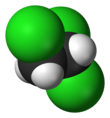1,1,2-Trichloroethane
1,1,2-Trichloroethane
Names
Preferred IUPAC name
Other names
1,1,2-TCAarchaic )
Identifiers
ChEBI
ChEMBL
ChemSpider
ECHA InfoCard 100.001.061
KEGG
UNII
InChI=1S/C2H3Cl3/c3-1-2(4)5/h2H,1H2
Y Key: UBOXGVDOUJQMTN-UHFFFAOYSA-N
Y InChI=1/C2H3Cl3/c3-1-2(4)5/h2H,1H2
Key: UBOXGVDOUJQMTN-UHFFFAOYAA
Properties
C2 H3 Cl3
Molar mass
133.40 g/mol
Appearance
colorless liquid[ 1]
Odor
sweet, chloroform-like[ 1]
Density
1.435 g/cm3
Melting point
−37 °C (−35 °F; 236 K)
Boiling point
110 to 115 °C (230 to 239 °F; 383 to 388 K)
0.4% (20°C)[ 1]
Vapor pressure
19 mmHg (20°C)[ 1]
Hazards
NFPA 704
Explosive limits
6–15.5%[ 1]
Lethal dose or concentration (LD, LC):
1200 mg/kg (rat, orally)[ 2]
13,100 mg/m3 (cat, 4.5 hr)[ 3]
NIOSH
TWA 10 ppm (45 mg/m3 ) [skin][ 1]
Ca TWA 10 ppm (45 mg/m3 ) [skin][ 1]
Ca [100 ppm][ 1]
Related compounds
Related compounds
1,1,1-Trichloroethane ; Trichloroethylene
Except where otherwise noted, data are given for materials in their
standard state (at 25 °C [77 °F], 100 kPa).
Chemical compound
1,1,2-Trichloroethane , vinyl trichloride or 1,1,2-TCA , is an organochloride solvent with the molecular formula C2 H3 Cl3 and the structural formula CH2 Cl—CHCl2 . It is a colourless , sweet-smelling liquid that does not dissolve in water , but is soluble in most organic solvents . It is an isomer of 1,1,1-trichloroethane , and a byproduct of its manufacture.
It is used as a solvent and as an intermediate in the synthesis of 1,1-dichloroethylene .[ 4]
Toxicity
1,1,2-Trichloroethane may be harmful by inhalation, ingestion, and skin contact. It is a respiratory and eye irritant. 1,1,2-TCA is a central nervous system depressant and inhalation of vapors may cause dizziness, drowsiness, headache, nausea, shortness of breath, and unconsciousness.[ 5]
The Occupational Safety and Health Administration and National Institute for Occupational Safety and Health have set occupational exposure limits to 1,1,2-Trichloroethane at 10 ppm over an eight-hour time-weighted average.[ 6]
References
Alcohols Barbiturates Benzodiazepines Carbamates Flavonoids Imidazoles Kava constituentsMonoureides Neuroactive steroids Nonbenzodiazepines Phenols Piperidinediones Pyrazolopyridines Quinazolinones Volatiles /gases Others/unsorted
3-Hydroxybutanal α-EMTBL AA-29504 Alogabat Avermectins (e.g., ivermectin )Bromide compounds (e.g., lithium bromide , potassium bromide , sodium bromide )Carbamazepine Chloralose Chlormezanone Clomethiazole Darigabat DEABL Deuterated etifoxine Dihydroergolines (e.g., dihydroergocryptine , dihydroergosine , dihydroergotamine , ergoloid (dihydroergotoxine) )DS2 Efavirenz Etazepine Etifoxine Fenamates (e.g., flufenamic acid , mefenamic acid , niflumic acid , tolfenamic acid )Fluoxetine Flupirtine Hopantenic acid KRM-II-81 Lanthanum Lavender oil Lignans (e.g., 4-O-methylhonokiol , honokiol , magnolol , obovatol )Loreclezole Menthyl isovalerate (validolum) Monastrol Nicotinic acid Nicotinamide Org 25,435 Phenytoin Propanidid Retigabine (ezogabine) Safranal Seproxetine Stiripentol Sulfonylalkanes (e.g., sulfonmethane (sulfonal) , tetronal , trional )Terpenoids (e.g., borneol )Topiramate Valerian constituents (e.g., isovaleric acid , isovaleramide , valerenic acid , valerenol )


